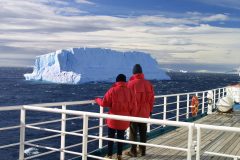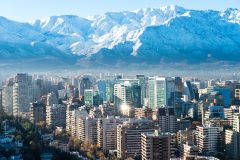Voyage to the Centre of the Earth

"Quito's a quiet place," said my friend Lina. "The really noisy people are all in Guayaquil down on the Pacific"
There is indeed every reason to think of the Quiteños as quiet people. They've got a lot to be quiet about. The history of the aboriginal peoples has been a tragic one: for centuries the Quichua peoples who inhabit the high Andes were treated as slave labour by the mestizos, those with European blood in their veins, the descendants of the Spanish conquistadors who arrived here early in the sixteenth century. For years land would be sold by the mestizos with its complement of animals and indians.
And perhaps the struggle to survive in the thin air of the high Andes, where the Ecuadorean capital sits at 2,800 metres above Guayaquil, makes you unwilling by nature to shout and lark about like those at sea level.
The Saturday night concert then in the Plaza Grande in the capital therefore came as a shock. The city's beautiful main square was floodlit and full of exited people. The presidential palace, the colonial cathedral and the handsome modern city hall looked at their best under a clear sky and a bright moon as the quiteños crowded in to enjoy themselves. The city was holding a celebration of the anniversary of becoming the first city to be named by UNESCO as a world cultural heritage site. (It got there years before better-known cities.) The National Youth Orchestra took their places beside the cathedral as the spotlights and projectors made its walls come alive with images and the smoke generators produced the necessary sense of mystery.
The maestro took up his baton and for a couple of hours the players produced very enjoyable music for the audience on the spot and the television viewers at home. The culmination of the performance came with Tchaikovsky's 1812 overture, inspired by Napoleon's failed campaign to conquer Russia. In the middle the skies came alive with the fireworks of war. The fact that the explosions of the rockets in the sky and the cries of joy from the spectators on the ground often drowned out the music didn't make the evening any less of a success.
Clearly Quito is not always a quiet city. The oil boom at the end of the 20th century has meant that the capital has expanded voraciously along the narrow valley in which it is contained, the poor people crowding into south Quito and the richer folk spreading themselves out in the north. For every one person who lived in Quito in 1950 seven live here now. The city's population has risen to 1.4 million. A complete traffic jam has been narrowly averted by the digging of a few well placed tunnels.
An injection of cash from oil has meant that the city fathers have been able to do justice to the distinction Quito received from UNESCO. They have beautifully renovated the churches, monasteries and convents, such as San Agustín, Santa Clara, Santo Domingo and the other monuments in the historic centre of the city which make Quito outstanding among the architectural treasures of the American continent.
The Jesuit church, the Compañía, whose interior is almost competely plated in gold, is particularly fine. Equally importantly the authorities have drafted in more police so as to make the central area safer for pedestrians in what had been a run-down and dangerous area. Seven thousand street vendors have been ordered to move on, the lucky ones getting stalls in small markets the city council has built for them.
Founded in 1534, eight years after the first Spaniards arrived in what is now Ecuador, by Sebastian de Benalcázar on the orders of the conquistador and ruffian Francisco Pizarro, the city knows it has a special place in the continent's history.
Many other cities were founded from here by the Spaniards and from here at Pizarro's behest Franciso de Orellana set out on one of the most daring journeys man has ever undertaken. With several thousand men he plunged down the eastern side of the Andes, sailed down the wild River Marañon, along the sluggish Amazon. Harassed by tribes of cannibals and stricken by disease he eventually reached the Atlantic Ocean with only a handful of those with whom he had set out. He turned up years later back in Spain. A big stone plaque on the outside wall of the cathedral proclaims to everyone that Quito takes a pride in having discovered the River Amazon.
The city became a centre for religious art in Spanish colonial days. Caspicara, a sculptor in wood, and the pupils gathered round him in what became known as the Quito School, gained a particular reputation for the quality of the statues he produced. Nuns in full habit walk through the city: Quito is still very religious, a trait which, they say, has been strengthened by the fact that it has often been severely shaken by earthquakes. The city is built on the eastern slopes of Pichincha, a dormant volcano. There were seven major tremors last century and the surrounding volcanoes have a habit of filling the capital with the ash from their craters and sometimes shutting the airport. Nevertheless the sight and presence of the snow-covered peaks, Antesana and Cotopaxi, is astonishing. Out of sight are many many others, Cayambe, Chimborazo, along what they call ‘the Avenue of the Volcanoes’.
In the 18th century Quito became better known in Europe because of the presence here of French scientists such as La Condamine whose investigations confirmed earlier calculations by the indigenous peoples that Quito lay on the equator.
The line is marked out at the Mitad del Mundo, a few kilometres north of the city. Whereas at Greenwich you can have one foot in the eastern hemisphere and the other in the western, here you can have yourself photographed with one foot in the northern hemisphere and the other in the southern.
As the work of restoration of the old city continues Quito is becoming an ever more attractive place to visit. The people also are very friendly and welcoming. Though at times, one has to admit, they are on the quiet side.
Hugh O'Shaughnessy
Tailor-made holidays
Flexible, custom-made holidays to Latin America created to match your exact requirements: our tailor-made itineraries are as unique as the clients for whom they are designed.
Design my tripPapagaio
Your edit for Latin American inspiration
Our exciting range of articles on Latin America explore everything from iconic destinations and lesser-known cultural gems to delicious traditional recipes. You’ll also find exclusive travel tips, first-hand client reviews and the chance to get your personal questions answered by our travel experts.
View Extraordinary Inspiration






































